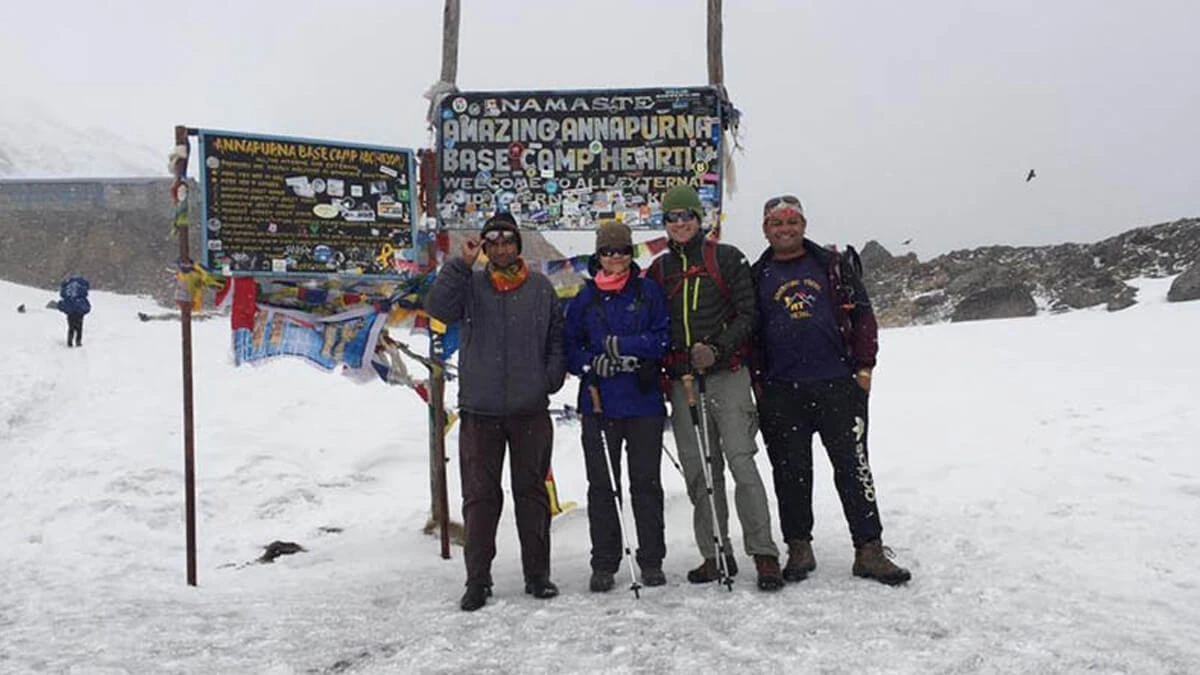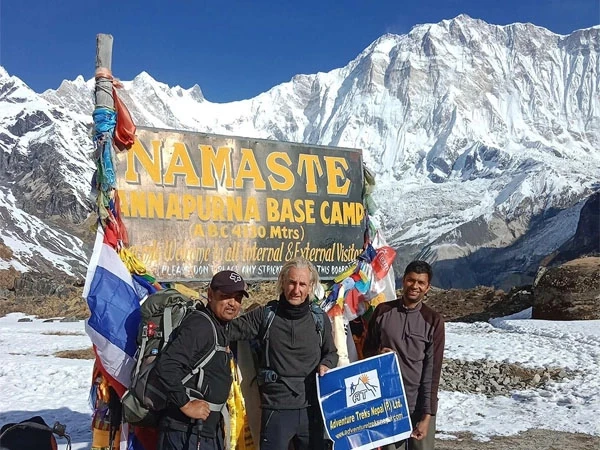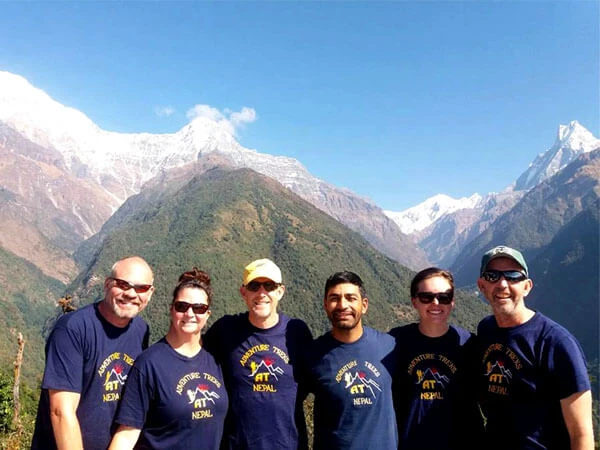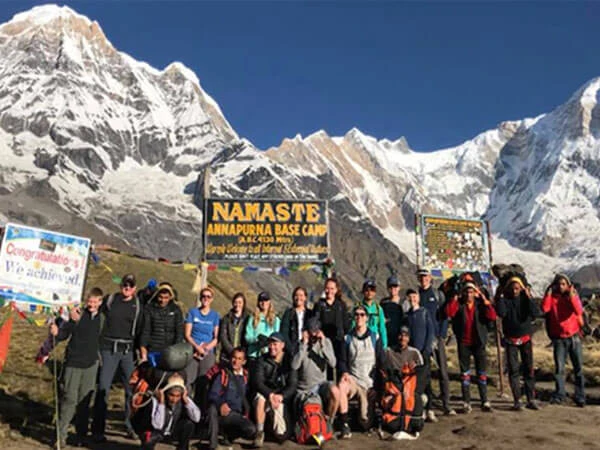What is the difference between the Annapurna Circuit and Annapurna Base Camp trek?
Trekkers usually compare the Annapurna Circuit vs. Annapurna Base Camp before the trek around Annapurna to know which one will give better experiences of high-altitude trekking in Nepal. The Annapurna Circuit trekking route encircles Mt. Annapurna (8091 m), the tenth-highest peak on Earth, traversing diverse topography via Thorong La Pass (5416 m), one of the mighty high mountain passes.
Meanwhile, trekking to the Annapurna Base Camp directly leads you to the foothills of Mt. Annapurna at an elevation of 4130 m for breathtaking vistas of towering mountains. From a child of 3 years to a 70-year-old elderly member of the family, all have loved this trip in previous days. Nevertheless, it is in your hand to choose between Annapurna Base Camp and Circuit.
Where do the Annapurna Circuit route and trekking to the Annapurna Base Camp begin and conclude?
Generally, the official Annapurna round trek that begins from Beshisahar and ends in Pokhara is considered the classic route of the Annapurna Circuit. Before reaching the initial point of the trekking, you will enjoy a scenic drive on the Prithivi highway and Dumre-Beshisahar road alongside rivers as well as traditional cultural villages after leaving the hustle and bustle of the capital city. When the walking stops, again, a 4WD takes you to the city of lakes, Pokhara, in a private jeep.
However, there is the option to shorten the itinerary so the hiking distance is possible, like other trekkers do these days, directly reaching the village of Chame by a road ride. For better encounters of cultures and nature, do not miss any parts of the routes because each destination, including Manang, Thorong La Pass, and Jomsom, presents surprises with its great transformation from dense, lush subtropical woodlands to arid mountainous landmarks of high elevations.
Like the circuit route, the trekking to the Annapurna Base Camp trail is also customizable, although most hikers prefer starting from Nayapul or Kimche, near Pokhara. Since the same trail or nearby routes bring you back to Pokhara after reaching Annapurna Base Camp (Ghandruk, Chhomrong, Deurali, Jhinu Danda), you will get a chance to understand local cultures and places deeply.
Annapurna Base Camp trekking becomes more memorable as its official walk concludes at Jhinu Danda, a famous stop for its awe-inspiring vistas and natural hot springs. In the serenity of this place, you get refreshed mentally through its cool air and beautiful scenery, while dipping in hot waters will heal all your physical pains due to prolonged periods of hiking in higher terrain.

How long do the Annapurna Circuit trek and the Annapurna Base Camp Trek take?
The Annapurna circuit route is doable within 12 days to 18 days, as its hiking trail distance is approximately 160 km to 230 km. Meanwhile, the Annapurna Base Camp trek is possible to complete within 7 days to 16 days, depending on the hiker’s choice. The distance to cover on the ABC trek is only 85 to 110 km. Due to the difficulty level of the Annapurna circuit trekking, it takes longer than the base camp trip.
The circuit takes you to higher landmarks than the base camp trekking, requiring more acclimatization days. Comparing days to complete the Annapurna Base Camp route vs. Annapurna Circuit, analyze yourself, which will provide better exploration in the Annapurna region.
What are major vantage points on the Annapurna Base Camp route vs. the Annapurna Circuit?
Whether you choose the Annapurna Circuit or the ABC route, you will experience the best views of the Himalayas and get a golden opportunity to capture them on your camera roll. The Anapurna circuit trek tour offers breathtaking sights of Mt. Annapurna II, III, IV, Gangapurna, Khangsar Peak, Lamjung Himal, the Chule range, and Tilicho Peak. Meanwhile, trekking to Annapurna Base Camp allows you to savor the charms of snow-clad peaks, including Mt. Annapurna, Machhapuchhre, Annapurna South, Dhaulagiri, Nilgiri, Hiunchuli, and other surrounding mountains.
Annapurna Circuit route’s viewpoints
Major spots for wonderful scenery on the Annapurna circuit trekking route are Ghore Pani, Manang Valley, Australian Camp, Tilicho Lake, Thorong La Pass, Muktinath, Kagbeni, and Jomsom. Ghorepani Poon Hill, which is also a part of the ABC trek, is popular for the sunrise view and panoramic scenes of the Dhaulagiri and Annapurna ranges. Although Australian Camp is also famous for the same reason, it is less crowded and an alternative destination.
Tilocho Lake, being one of the highest lakes in the world at an elevation of 4919 m, trekkers love visiting it to capture the beautiful photographs of turquoise waters and awe-inspiring mountainous scenery. Thorong La Pass (5416), the highest point of the Annapurna circuit, will offer the best views. Before concluding the trek, you will get to visit a sacred site of Muktinath, revered by both Buddhists and Hindus.
There are 108 taps, divine water sources known as Muktidhara, believed to cleanse one’s sins during bathing. If you want spiritual satisfaction together with a wonderful scenario, visit Muktinath. Before heading down to Pokhara by a private jeep or plane, enjoy the environment of Jomsom. There is a famous Nepali song named “Jomsomai Bazaara Barha Baje hawa Sarara,” which indicates that trekkers can savor the charm of the vibrant settlement of Jomsom with cool wind blowing, especially after midday.
Jomsom is also a popular place for its apple orchards, where you not only get a chance to click photographs but also taste various types of apples. This way, your Annapurna Circuit trekking becomes fascinating.
Vantage Points on the Annapurna Base Camp trekking trail
Leaving the busy life of the cities of Kathmandu and Pokhara behind, you will enter the route to the Annapurna Base Camp after reaching Nayapul/Ghandruk/Jhinu Danda, depending on your ABC trek itinerary. While on this odyssey, most preferred places for wonderful sceneries are Ghorepani Poon Hill, Ghandruk, Chhomrong, Deurali, Machhapuchhre Base Camp, and Annapurna Base Camp.
While we have already mentioned Ghorepani Poon Hill above, Ghandruk is also one of the most beautiful Gurung villages, where tourists enjoy spending time in a peaceful environment, encompassed by green hills, snow-clad peaks, and dense forests. Meanwhile, the village of Ghandruk will allow you to visit museums such as the “Old Gurung Museum” and the “Ghandruk Cultural Museum,” which will showcase centuries-old traditions of the Gurung community through preserved household items, cultural attire, ornaments, sculptures, and weapons used in past times.
The second one also allows you to try traditional dresses for a photoshoot, providing knowledge about such customs and jewelry. As the quaint village of Chhomrong is a gateway to the Annapurna Base Camp (4130 m), the scenes of Annapurna and Machhapuchhre become more dramatic, making this place a perfect pausing point. Deurali, the last settlement with services of teahouses before reaching the Annapurna Base Camp, also provides close-up scenes of high mountains.
As Machhapuchhre Base Camp (3700 m) is a side trip on the ABC trekking route, all itineraries may not include it. However, we also recommend visiting it for the most wonderful vistas of Machhapuchhre and also making your dream come true by reaching two base camps at a time. The most anticipated place is Annapurna Base Camp for a 360° Himalayas vista while being satisfied to leave your footprints at the base of iconic Mt. Annapurna.
Which route offers better services: Annapurna Circuit or Annapurna Base Camp?
The facility difference between the Annapurna Base Camp and Circuit is that the ABC route will provide more enhanced amenities, while trekking on the Circuit trail means compromising with common facilities due to more isolated areas. Nevertheless, villages alongside the paths of the Annapurna region trek have more options, from a common teahouse to more facilitated lodges, compared to the Kanchenjunga and Everest routes.
When your steps proceed upward on the Annapurna circuit trail, leaving Beshisahar behind, you will find simpler teahouses, guesthouses, homestays, restaurants, and lodges that provide common food menus and services. However, locals welcome you with happy faces, providing you with better hospitality in a traditional way. On both base camp and circuit routes, only limited areas will provide infrastructure such as hot showers, wifi, and health services.
When Is the Best Season for the Annapurna Circuit vs. Annapurna Base Camp?
The optimal period for these two treks is not just a basis for choosing Annapurna Circuit or Annapurna Base Camp. Nevertheless, know which trek is possible to trek year-round while comparing their difficulty level and other possible happenings. Since a trail to ABC is better marked as well as developed, it is achievable even in monsoon and winter with the best preparation and crucial equipment.
Since the total hiking distance and duration, as well as daily walking length, are moderate, a carefully planned base camp will make it possible to reach during all seasons. An experienced guide helps you to navigate paths with the help of a detailed map and GPS tool. In case the major trail gets blocked, only a license holder can save you from getting lost or having to return to Kathmandu.
Although we have records of conducting several Annapurna Base Camp treks during off-seasons, our advice for you is to plan a trip during spring (March to May) and autumn (September to October). When the weather is pleasant with moderate temperature, a hike will be safer and more comfortable than on slick, muddy, and icy trails. In heavy rains, the risk of landslides might ruin your trek and harsh cold might increase the possibility of acute high sickness and cold-related health issues when a temperature declines to freezing.
How Much Do the Annapurna Circuit and Base Treks Cost?
While talking about the cost for the Annapurna Circuit vs. Annapurna Base Camp, they depend on various factors such as the chosen itinerary, preferred services, trek supports (guide and porter), and the duration and length of the trek. However, the Annapurna Circuit Trek cost is generally a bit pricier than the ABC trekking due to the route’s remoteness and longer duration for walking.
In the higher altitude of the Annapurna circuit, spending more days means adding additional expenses to the total cost, as you have to pay for hiking logistics, including trekking permits, accommodation, and other services for each day. If you see our packages for the Adventure Treks Nepal, all are very affordable and might meet your economic condition. For budget trekking with the affordable Annapurna trek cost, you can customize your itinerary as well as compromise on some services without sacrificing a better Himalayan experience.

Annapurna Circuit and Base Camp Treks: Which is harder?
Trekking on the Annapurna Circuit route is both challenging and rewarding due to its high altitude, particularly at Thorong La Pass, which is higher than Everest Base Camp (5364 m). Without proper acclimatization and a sound body and mental condition, crossing this high pass becomes more demanding, leading to worse circumstances because of high-altitude-related health issues or potential risks of getting injured on uneven paths.
Even though the ABC Trekking Trail also involves some dangerous zones, including landslide-prone areas and steep sections, it is easier than the Annapurna Circuit, and its difficulty level is moderate. In comparison, the Annapurna Base Camp trek is moderate, typically completed in 7–10 days. It involves steep ascents and descents but does not reach extreme altitudes like the Circuit. It’s suitable for beginners and families with reasonable fitness levels.
Conclusions
To sum up, with this comparison between the Annapurna Circuit route and trekking to the Annapurna Base Camp, I hope you have mentally prepared yourself for the right one between these two. However, our team at Adventure Treks Nepal is always ready to serve you and provide you a better service during the Annapurna region trek in Nepal. If you want other packages that are easier than the Annapurna Circuit Trek and Annapurna Base Camp trekking, we can manage the Ghorepani Poon Hill Trek and the Mardi Himal Trek in the same region.
As you wish, we also have itineraries for regions like Everest, Kanchenjunga, and Langtang. Accordingly, do not delay, as bookings for peak seasons, including the Annapurna trek in October, are open now. For further inquiries, contact us on WhatsApp or email. Do not stay in a dilemma by thinking Annapurna Circuit vs. Annapurna Base Camp; choose one, and create indelible memories for a lifetime with us, as one offers a mix of dry mountain valleys, lush woodlands, and centuries-preserved Thakali cultures, while the other will shower you with the natural charms of the Annapurna Sanctuary in a shorter duration on less strenuous trails.
FAQs
What trekking permits are required for Annapurna circuit and Annapurna Base Camp treks?
Generally, both Annapurna region treks, Annapurna Circuit and Base Camp, require two trekking permits, such as a TIMS (Trekkers Information Management System) card and an Annapurna Conservation Area Permit, which are essential paper documents that will be processed through the chosen trekking companies in Nepal. However, if you include nearby destinations like Upper Mustang and Nar Phu Valley on your circuit trail, you need to attain restricted area permits.
Why is travel insurance important for both Annapurna circuit route and trekking to ABC?
Obtaining travel insurance for such trekking around Annapurna means protecting yourself from unpredictable financial losses for emergency helicopter evacuation above 4000 m and medical treatment in some cases due to critical issues or injuries. However, ensure that the travel insurance covers other unexpected incidents like flight cancellation/delay or personal belongings loss or damage during the journey.
What to pack on Annapurna Circuit Trek and Annapurna Base Camp trekking?
Depending on the season, carry appropriate layers (base, mid, and outer) to protect yourself from UV rays, chilly winds, and severe cold. Meanwhile, you should not miss essential trekking equipment, including a sleeping bag, trekking bag, and durable boots, as well as things for personal health and hygiene. Headlamps with extra batteries, cameras, diaries, journals, and storybooks are additional, which are really beneficial to make these Annapurna region treks more enjoyable.
Which trek requires a compulsory guide: Annapurna Circuit or Annapurna Base Camp?
Whether it's Annapurna Base Camp or Annapurna Circuit, an experienced guide is mandatory according to the rules and regulations of the Nepalese government. Even you cannot obtain trekking permits without a guide. Guides not only help you in navigating trails and organizing all trekking logistics but also assist in preventing high-altitude-related health issues, as they are well trained for such things.
What can you eat on Annapurna Circuit and Annapurna Base Camp trek?
The best thing you can have as a meal is “Dal Bhat” (steamed rice, green vegetables, pickle, and salad), which is affordable as well as available at teahouses alongside the paths of Annapurna trekking tours. At your request, meat and other food items (Western and Tibetan) are also found at restaurants and hotels of large settlements in limited amounts.









